| Article ID | Journal | Published Year | Pages | File Type |
|---|---|---|---|---|
| 2957892 | Journal of Arrhythmia | 2013 | 5 Pages |
Brugada syndrome (BS) is characterized by ST-segment elevation in the right precordial leads and is associated with sudden cardiac death secondary to polymorphic ventricular tachycardia (PVT)/ventricular fibrillation (VF) in the absence of structural heart disease. Vasospastic angina (VSA) and neurally mediated syncope (NMS) are observed occasionally in BS patients, although their associations with BS remain controversial. The incidence of concomitant VSA and BS is 11–13%, and there might be an increased risk of VF when BS and VSA coexist, as reported in several previous studies. Whether the manifestation or augmentation of a coved-type electrocardiography (ECG) pattern is associated with coronary artery vasospasm is unclear. The significance of increased coved-type ST-segment elevation and its relation to arrhythmogenesis in BS is an important issue that needs to be resolved in future studies of concomitant BS and VSA. The coexistence of BS and VSA should always be taken into account in the management of both conditions, particularly when calcium antagonists are used. Previous reports suggest a high incidence of NMS in BS patients, and it is often difficult to differentiate between NMS and high-risk syncopal episodes due to ventricular tachyarrhythmias. Therefore, the identification of a therapeutic strategy to treat syncope in BS patients is often problematic. The autonomic nervous system is involved in arrhythmogenesis and may precipitate cardiac events in BS patients. To investigate BS, it may be useful to consider VSA and NMS as concomitant abnormalities. Future studies are needed to understand the relationship between BS and the autonomic nervous system.
